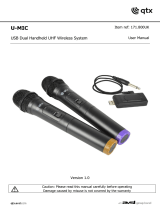RU105 User Manual
If the receiver is to be rack-mounted, place the supplied rack ears against each side of the receiver
and fix securely with 2 screws in each. These rack ears have a hole for front-mounting the antenna
and a BNC extension lead for fixing into the hole. This should be connected to the BNC on the rear
panel, creating a front socket for the antenna to connect onto.
A choice of unbalanced 6.3mm jack or balanced XLR output is available on the rear panel of the
receiver. Connect the jack or XLR (optional) lead to the relative output connector, turn down the
volume of any equipment (mixer, amplifier etc.) that the signal will be fed into and then connect the
jack or XLR to the equipment.
Position the receiver within the best available line of sight to the transmitters and connect the DC
jack of the supplied power adaptor to the receiver and the plug top to the mains outlet.
Operation
Turn microphone levels down on the receiver and switch on power on the front panel of the receiver.
Warning! - take care not to point microphones towards speakers – this can cause damaging feedback
(loud whistle or howling noise) – try to point microphones away from the speaker cabinets.
For the handheld version, move the switch on the handheld transmitter upward to switch it on and
the LCD display should light for a few seconds, showing the carrier frequency and battery status.
For the bodypack transmitter, press and hold the front on/off button until the display lights up for a
few seconds, ensuring that the Mute switch is off. The display will show the current carrier frequency
and battery status. The transmitter frequency should match the frequency on the receiver. If not,
see “Tuning” below.
Gradually increase the microphone level on the receiver, then increase the volume on the mixer or
amplifier until the sound from each microphone can be heard through the equipment.
Tuning
The carrier frequency may be selected on the receiver unit by pressing the SET button twice, which
causes the GROUP label to flash in the display. The and buttons can be used to select the
Group from 1 to 7. Pressing the SET button again causes the CHANNEL label to flash. The channel
can be selected within a group using the and buttons.
Groups 1 to 6 have between 3 and 5 preset channels, whilst Group 7 allows access to all 81 possible
frequencies. Depending upon any other radio signals in the vicinity of the operating environment,
one particular Group may offer a better channel spacing than another and this should be determined
by experimentation. If a particular group of frequencies results in poor reception or interference, try
another or use Group 7 to manually select carrier frequencies in 25kHz steps.
Once a channel is selected, press SET to accept the channel and press SET again to transmit the IR
sync signal (animated lines will show next to IR in the display). Hold the IR detector on the handheld
microphone or inside the bodypack battery compartment up to the IR sender on the main unit to
sync the carrier frequency to the transmitter (the transmitter must be switched on for IR sync)








